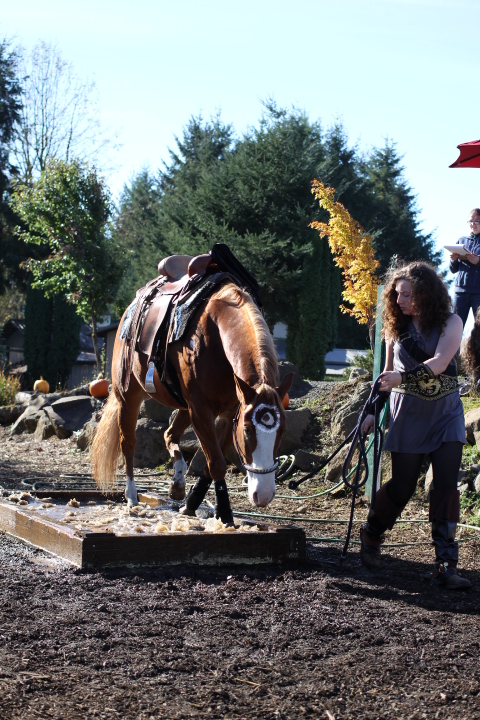How to Master a Challenging Obstacle
by Mark Bolender

An extreme trail obstacle that most horses hate is the squirting water box. This is a standard water box, but floating on top of the water is a 4’ x 8’ piece of plywood that has holes drilled into it. As soon as the horse enters the water box and steps on the plywood, water shoots up through the holes. Not only do most horses refuse to step into the box, but they leave upon the very first step. My own horse, Checkers, quickly left when he saw the water shooting up. So how do we teach a horse to master this daunting obstacle? Here are the steps I use that have worked quite well.
Before you Begin
First, wrap your horse’s legs to prevent injuries. And before you start the training you must have the horse’s respect. If you don’t, the horse will try to push into your personal space (what I call the “Bolender Bubble”). If this happens you must correct the behavior before proceeding any further.
Drive from the Ground
Once your space is respected, drive the horse from the ground to water box and have it inspect the obstacle. Do not force the horse, but give it all the time it needs to smell, chew or even paw the box if it so desires. Being curious creatures, most horses will place one foot in the water box and then take it out as soon as the water squirts up, and then repeat the process. You should apply gentle pressure to the horse until it moves forward and puts its foot back in the water box. Immediately stop all movement to take the pressure off, and let the horse think it through. This method will seem slow at first, but will pay dividends in the end because it builds more boldness and confidence than pushing the horse and forcing it to comply. The only force you need is to convince the horse that you are serious about it facing the water box and allowing it to think its way through. Without the added pressure, it will only perceive your encouragement.
As the Horse Gains Confidence
As the horse gains the confidence to step into the box with one foot, make sure your lead rope is loose. This is crucial because if the horse doesn’t stand in the water box on a loose lead rope then, in its mind, the effort never happened. Resist hanging onto the lead rope! Depending on the horse, placing both feet in the water box and then removing them is normal, and this happen many times. Once the horse has both feet in the water box and appears quiet, it’s time to apply pressure and ask it to step into the water box with its hind feet. Once again, when the horse steps into the water box with all four feet stop all pressure. Allow it to stand on a loose lead rope before moving on. At this point you will be facing the horse.
Mind Your Cues
Remember, in the horse’s mind the less you move your feet the more authority you have. So stay quiet, calm, and show no emotions. The horse will reward you by taking several baby steps. It may take a day or two before the horse walks completely relaxed through the water box in a relaxed manner while “hunting the trail” (head down and considering its moves). Once the horse has mastered the water box from the ground, then you can move to riding the horse. If the horse is still rushing to get through the box and/or jumping, then do not ride until the horse is relaxed and navigating it in the proper manner.Insert photo
In the Saddle

Once mounted, ask the horse to approach the water box. You must allow enough rein so the horse can drop its head and inspect the water box, but at the same time maintain soft reassuring contact. Do not be surprised if the horse does not walk right through the water box. Most will draw back at first when the water squirts up. Your job is to not show emotion, but present the water box again and maintain a soft reassuring leg contact while allowing the horse all the time it needs to think it through. In a short time the horse will approach the obstacle with its head down and boldly and confidently walk through the squirting water box.
Happy Trails and Bolender Blessings!
Published in December 2013 Issue

Mark and Lee Bolender own and operate Bolender Horse Park in Washington State, which houses the finest Mountain Trail course in the world. They are the founders of the International Mountain Trail Challenge Association (IMTCA) and travel worldwide as clinicians and ambassadors of Mountain Trail. Bolender Horse Park offers riders of all skill levels and disciplines a fun and challenging trail riding adventure.
Mark has designed and built Mountain Trail courses in the USA, Canada, Australia, and Europe—with many more in development. Mark uses his artistic, landscaping, horse training, and construction skills to build these courses (NW Steel Design LLC www.nwsteeldesign.com).
Mark is the author of Bolender’s Guide to Mastering Mountain and Extreme Trail Riding. Visit www.bolenderhorsepark.com to learn more.





